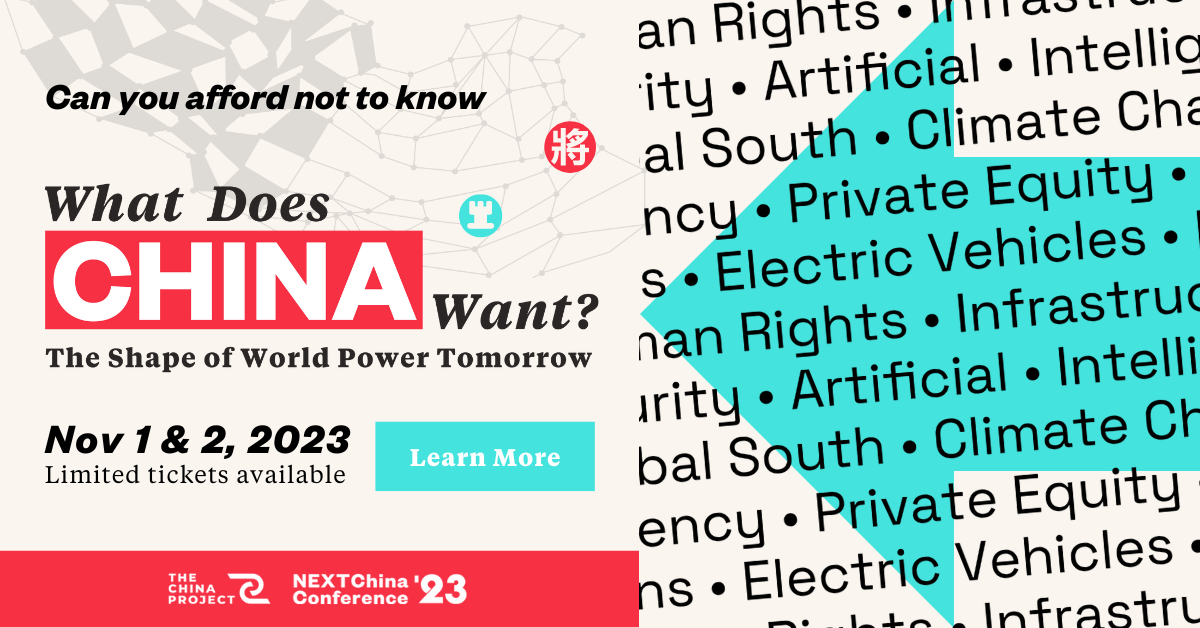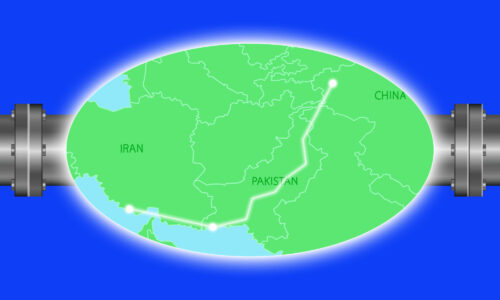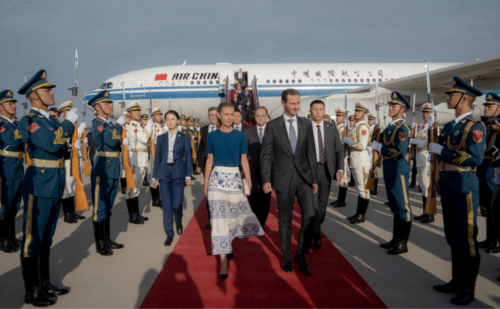Violence in Iran, Afghanistan, and Pakistan might sabotage China’s plans to move Middle Eastern oil to Xinjiang
Baloch nationalists and the Taliban are among the militants making China’s Belt and Road rocky.

On July 30, China’s Vice Premier Hé Lìfēng 何立峰 touched down in Islamabad where Pakistan’s Ministers of Planning and the Interior greeted him to kick off a celebration of the 10-year anniversary of the China-Pakistan Economic Corridor (CPEC), a development scheme budgeted at $62 billion.
Just hours earlier, near Pakistan’s border with Afghanistan, a suicide bomber killed himself and 44 others, and injured 200 more at a political rally in an area where Chinese money backs development projects that are exposed to regular threats of violence.
News of the blast cast a local shadow on international proceedings. As chairman of China’s National Development and Reform Commision (NDRC), Vice Premier He was instrumental in the planning of many of the CPEC investments. The bombing would have been front of mind when he met Pakistan’s former Prime Minister Shehbaz Sharif.
To get to Sharif from the airport, for the first of three days of meetings, Vice Minister He — an envoy of Xí Jìnpíng 习近平, China’s top leader and General Secretary of the Communist Party of China (CCP) — traveled a route guarded by 2,700 Pakistani police. He was the most important foreign guest Islamabad had received in some time.
The Chinese visitor was in Islamabad under tight security to focus his hosts’ attention on safety, or the lack thereof, around China’s investments. Violence has delayed CPEC, the crown jewel of Xi’s Belt and Road Initiative, in places such as the Gulf of Oman. China is helping Pakistan to position the port of Gwadar as a hub for shortening the distance Middle Eastern oil must travel to reach northwest China’s Xinjiang Uyghur Autonomous Region, by moving it overland instead of by sea through the Strait of Malacca.
Apart from the $62 billion budgeted for CPEC, inaugurated in 2013, Beijing expanded its regional investment and influence plans by signing, in March 2021, $400 billion in contacts with neighboring Iran to develop oil resources and the Makran Coast, 50 miles to the west of Gwadar, despite U.S. sanctions on Tehran.
The suicide bomber on the day of He’s arrival in Pakistan was a member of the Islamic State Khorasan Province (ISKP), the Afghan branch of ISIS, the transnational terrorist group. His target was a rally of a right wing conservative party in Khyber Pakhtunkhwa province — the Pakistan province bordering Afghanistan and closest to China. The blast occurred a three-hour drive from the Rashakai Special Economic Zone, a $128 million CPEC project designed to serve the region in, among other sectors, processing and manufacturing, agriculture, auto parts and pharmaceuticals.
Beijing and Islamabad believe that the ISKP provides shelter for regional militant groups — including extremists among China’s Muslim Turkic Uyghur population — responsible for a wave of terrorism in Pakistan and neighboring countries that is targeting Chinese nationals, many of them engineers. On August 13, not two weeks after Vice Minister He left Pakistan, extremists within the Baloch Liberation Army (BLA) attacked 23 Chinese port workers driving to Gwadar in a convoy of bulletproof vehicles. The Chinese survived and two attackers were killed by Pakistani security forces.
“Pakistan authorities should conduct a thorough investigation on the attack, severely punish the perpetrators, and take practical and effective measures to prevent similar incidents from happening again,” China’s Embassy in Islamabad said in a statement after the attack.
The suicide bombing and the Gwadar attack came hard on the heels of June 2023 counter-terrorism talks between China, Pakistan and Iran, talks in Beijing that inaugurated what the three countries said will be regular meetings to address rising militancy in the region.
The Pakistan-Iran rift
Rocky relations between Tehran and Islamabad began in 1979, when Iran’s revolution turned it into a Shia Muslim state, leaving Pakistan, where Muslims predominantly follow Sunni Islam, to wonder about their neighbors. Sunni and Shia are historical rivals, like Catholics and Protestants elsewhere.
Pakistanis and Iranians call themselves Muslim brothers, but they often accuse each other of harboring hostile militant groups that straddle their 565-mile-border, and the regional violence that results is an obvious threat to Beijing’s Belt and Road plans.
The border region is dominated by the Baloch people, about 6.9 million of whom live in Pakistan, another 2 million in Iran, and 500,000 in Afghanistan. Naseer Dashti, a Baloch writer, explains that the Baloch are a group of Indo-Iranic tribes who were called Balaschik when, 3,000 years ago, they began a southern migration from the Caspian region of Balashagan to the Iranian plateau and eventually to present-day Balochistan.
James Gethyn Evans, a visiting professor at the George Washington University who studies China’s relations with the Global South, said that Beijing’s investments often offer alternative power structures to disempowered minority populations.
“In Balochistan, they probably feel, ‘China is investing in our area. This gives us power and leverage over people who have traditionally discriminated against us or ignored us either in the central government or the colonial government,’” Evans told The China Project. “China is seen as this potential for them to escape oppression rather than necessarily as a beacon of Maoism.”
Some militant groups associate Chinese visitors — even if they’re engineers or laborers — with wealthy backers and investors and as potential pawns to be used as leverage against regional or national governments.
“Violence against Chinese nationals overseas therefore presents either potential revenue in the form of ransoms or an attempt to force government agents to the negotiating table so that they can extract power-sharing concessions,” Evans said.
Some of China’s CPEC projects represent an unwelcome change, where imported Chinese laborers highlight a replacement of local employees, which builds resentment against Chinese citizens.
“An overall feeling of systemic oppression allows for what appears to be a paradoxical viewpoint in which China is simultaneously an anti-Western ideal on the world stage and a perpetrator of persisting local inequality,” Evans said.
When China’s money began to flow into the region, the blame game for cross-border attacks did not die down. In fact, the trilateral meeting in Beijing with Iran and Afghanistan revealed China’s wish that Tehran and Islamabad work more closely together to protect Chinese investments.
“Lack of cooperation between Iranian and Pakistani governments on border issues, such as Baloch ethno-religious nationalists using insurgent groups in proxy wars against each other, has created problems for the security of Chinese employees and investments,” Hoshang Noraiee, an Iranian author based in the United Kingdom, told The China Project.
Balochistan was “the main issue” in the trilateral talks in Beijing, where Tehran raised cooperation for discussion, Noraiee said.
The border security issue is serious and complicated by rampant drug smuggling, said Muhammad Aamir Rana, a security analyst based in Islamabad.
“Beijing is interested in resolving this issue because it relates to the security of the CPEC in the region,” Rana told The China Project. “Through cooperation, the border and economic activities can be secure, and terrorism can dwindle.”
China’s ability to bring Islamabad and Tehran to the table was made possible, Rana said, by Beijing’s brokering in March 2023 a detente between Iran and another neighbor with which it has long been at odds: Saudi Arabia.
“This is one of the reasons that China has brought together Iran and Pakistan, after thawing the relations with Iran and Saudi Arabia,” Rana said.
Uniting China’s Middle Eastern friends Saudi Arabia, Iran and Pakistan calls for cooperation from their neighbor Afghanistan, where the Afghan Taliban, a group of Sunni fundamentalists, came to power in August 2021 when American military forces withdrew after more than 20 years.
The Afghan issue
After the U.S. withdrawal from Afghanistan, China met with the foreign ministers of the neighboring states to decide whether, or, if, to engage with the Taliban and if so, what kind of offerings could be made in return for assurances of security on the ground, Noorulain Naseem, Research Associate, Islamabad Policy Research Institute, told a Stimson Center panel discussion on China in South Asia in July 2023.
“There is a bilateral understanding, it seems, between China and Pakistan, Naseem said. “If not overtly in the form of a policy document, the engagements of the foreign ministers of both with the Afghan Taliban, really tells you that both China and Pakistan have an underlying tacit agreement that Afghanistan will be included in BRI and CPEC projects, particularly those that interconnect Central Asia through Afghanistan, to Pakistan.”

Yet after the U.S. withdrawal from Afghanistan, militancy rose in the region, particularly in Pakistan, where the majority religion is Sunni Islam, which ties it closely to Afghanistan.
Soon, the banned Sunni militant outfit Tehreek-e-Taliban Pakistan (TTP) and Baloch militants said to be hiding in Afghanistan increased attacks in Pakistan, including against Chinese nationals.
Ironically, the Afghan mujahideen, the forebears of some of the militants attacking Chinese in the region today, were, at the time of the 1979 invasion of Afghanistan by the forces of the former Soviet Union, helped by China, the U.S. and Israel.
Deteriorating security compelled China to appoint Sūn Yùxǐ 孙玉玺 as Special Envoy for Afghanistan Affairs in July 2014, tasking him with reaching out to Afghan stakeholders in the wake of increasing attacks. Sun was well known in the Taliban seat of power, Kandahar, having first arrived there in 1981 and later served as China’s Ambassador to Afghanistan from 2002-2005, filling a post left vacant since 1979.
In 2016, China rallied the militaries of Afghanistan, Pakistan, and Tajikistan to share counterterrorism intelligence to counter rising Islamic militancy. Critics have said that results were mixed at best.
“China cannot get rid of fundamentalism in the region…because China’s own policies are based on opportunism”
In March, 2017, Chinese assured Pakistan it would make more CPEC investments in its northeastern region, in the province of Khyber Pakhtunkhwa, including a $2 billion motorway between the cities of Dera Ismail Khan and Chitral.
Still, the violence continued. In September 2023, Pakistan’s Dawn newspaper reported a band of TPP militants crossed over into Chrital to attack Pakistani positions before retreating in Afghanistan.
“It’s an open secret. China cannot get rid of fundamentalism in the region along with Pakistan, because China’s own policies are based on opportunism,” Farooq Sulehria, a teacher at Beaconhouse National University in Lahore, said. “At the same time, both Pakistan and Iran are fundamentalist countries that have encouraged fundamentalism in the region, instead of fighting or putting an end to it.”
Despite this, Sulehria told The China Project that Beijing patronizes Tehran and Islamabad to bolster their struggle against American influence in the region, Sulehria said.
This extends even to dealing directly with the Taliban. Soon after U.S. forces withdrew from Afghanistan in December 2021, China expressed interest in investments there. In January, 2023, Beijing signed a deal with the Afghan Taliban to invest $150 million a year in Afghan oil drilling for 25 years, despite the fact that the Taliban government was unrecognized around the world.
On September 13, 2023, China appeared to become the first country to send an ambassador to Afghanistan since the Taliban took over, even if China’s Foreign Ministry has made no such announcement.
“If China recognizes Afghanistan, then Pakistan and other countries, including Iran, can follow suit,” Muhammad Arif, a Professor of International Relations at the University of Balochistan, said.
The Uyghur issue
Closer to home than any danger from militants in Balochistan is the threat Beijing perceives from the East Turkestan Islamic Movement (ETIM), which was founded by radicalized Uyghurs, a Muslim Turkic people from Xinjiang, an area of northwest China as big as Alaska that borders eight countries, including Pakistan and Afghanistan.
Washington designated ETIM a terrorist organization in 2002, when American policymakers wanted Beijing on board for its War on Terror after the attacks on the U.S. on September 11, 2001. A United Nations Security Council report calls ETIM an al-Qaeda-affiliated militant group that has conducted attacks on China from bases in Afghanistan.
Just as the Afghan Taliban co-exists with the TTP and Baloch militants, it has not chased off the ETIM, many of whose members live in the far eastern tip of Afghanistan near the 47-mile border with China. Some analysts believe ETIM’s reported attacks on China are in pursuit of the recreation of East Turkestan, the short-lived independent Muslim states that lasted in Xinjiang from 1933-34 and 1944-46. But the only reports of ETIM activities in at least five years have been in China state media and propaganda articles.
Meanwhile, most of Xinjiang has been under Chinese lockdown since 2017, with over one million Uyghurs believed to have been detained, imprisoned, or pushed into forced labor.
Pakistan has addressed Chinese concerns about the ETIM presence in the tribal lands bordering Afghanistan, but Kabul’s ambivalence about the Uyghurs in their midst has prompted more Chinese investment there so as to build Beijing’s influence and encourage the Afghan Taliban to push the radical Uyghurs out.
“China is opposed to all kinds of extremism and terrorism in the region and elsewhere,” a Chinese former official in Pakistan who asked not to be named told The China Project. “China wants a peaceful environment where it can do business peacefully along with other countries.”
As of 2022, China’s direct investments of $25.4 billion in CPEC had created about 236,000 jobs, generated 8,000 megawatts of electricity and built 550 miles of transmission grid, data from the Chinese Embassy in Pakistan showed.
“As for Pakistan,” he added, “It has been doing all it can to put an end to extremism and terrorsim in the region.”
At the trilateral anti-terrorism meeting in Beijing Tehran presented ways to prevent a humanitarian crisis in Afghanistan, post-U.S. withdrawal, while making sure it does not become a center for regional terrorism.
“Each country has an interest in events in Afghanistan, but I am not sure China has the necessary clout to dictate an agenda for Tehran or Islamabad,” said Alex Vatanka, founding director of the Iran program at the Middle East Institute.
Muhammad Feyyaz taught counter terrorism at China’s National Defense University. Based in Lahore, Feyyaz told The China Project that as a new great power, China is trying to resolve issues in its neighborhood in order to secure its borders and the region.
There’s also the matter of wanting to recoup the $3 billion China paid Afghanistan to extract copper from the giant Aynak mine 25 miles southeast of Kabul, operations that stopped long ago due to violence in Afghanistan.
“China’s strategy is one of sustained engagement, open to negotiations with Pakistan and Iran over the issue of extremism in the region,” Feyyaz said. “It may be checked and put to an end over the long term in order to further China’s economic interests.”
Fatima Raza, Ph.D. candidate in International Relations, Quaid-i-Azam University said that while CPEC has contributed to direct jobs and employment opportunities for the local population, the problem lies with Pakistan’s internal institutional weaknesses and ineffective planning.
“There have been a lot of implementation gaps that have stagnated the progress of the project,” Raza told a Stimson Center panel discussion in July 2023. “And while these barriers, in my opinion, have not demoted Pakistan from the position of importance that it holds for China and China’s South Asia policy, the stagnation has now highlighted the need for some sort of change and some sort of improvement that is badly needed with regards to Pakistan’s economic outlook, and serious steps now need to be taken.”








